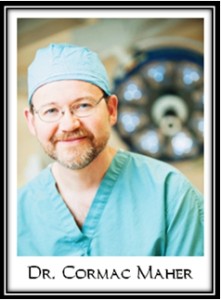Interview With a Neurosurgeon
 This past month I had the pleasure of corresponding with a very prominent neurosurgeon. Dr. Cormac Maher specializes in skull base tumors, often the location for Epidermoid Tumors. In fact, in full disclosure, he is the Neurosurgeon who operated on me. To be exact he is a Pediatric Neurosurgeon, but when I saw one of the head adult Neurosurgeons at the University of Michigan, he told me (regarding my tumor) “Chris, I am going to have one of my colleagues, Dr. Maher a Pediatric Neurosurgeon, see you. To be honest, he is much more experienced than I in this location. If it were my son I’d want him to see Dr. Maher.”
This past month I had the pleasure of corresponding with a very prominent neurosurgeon. Dr. Cormac Maher specializes in skull base tumors, often the location for Epidermoid Tumors. In fact, in full disclosure, he is the Neurosurgeon who operated on me. To be exact he is a Pediatric Neurosurgeon, but when I saw one of the head adult Neurosurgeons at the University of Michigan, he told me (regarding my tumor) “Chris, I am going to have one of my colleagues, Dr. Maher a Pediatric Neurosurgeon, see you. To be honest, he is much more experienced than I in this location. If it were my son I’d want him to see Dr. Maher.”
Neurosurgery is an amazing field; one that not only requires exact precision, but also one that demands an incredible amount of time and devotion. Knowing this, I was very grateful that Dr. Maher would take time out of his busy schedule to answer my questions. This is what I asked him:
CC: First off, Dr. Maher, I wanted to thank you for taking the time out of your day to answer these questions.
Are there locations that are more common for you to see?
CM: The most common location that I see are lesions located just to the side of the brainstem, wedged in the “CPA” or cerebellopontine angle.
CC: For patients whom which the wait and watch alternative is taken, are there specific intervals with which you monitor the tumors?
CM: I think the proper follow-up interval will depend on patient-specific factors such as the age of the patient, the presence of any symptoms, and the size and location of the epidermoid. I would follow larger lesions with much more frequent scanning than tiny lesions. I would also follow with more frequent scanning if I thought that any neurological structures such as cranial nerves would be in jeopardy if the lesion grew. Most importantly, I would monitor very closely if the lesion was threatening to obstruct the flow of cerebrospinal fluid pathways, possibly resulting in hydrocephalus. Of course, if a lesion is very worrisome – either because of its location, size, or symptoms – we tend to offer surgery as a first line of treatment.
CC: What new surgical approaches you advocate?
CM: It really depends where the lesion is located. For some intraventricular lesions or lesions at the skull base, endoscopic removal has become more accepted as a first choice therapy. This has the advantage of a more minimal approach and a shorter hospital stay. For most epidermoid lesions, their location makes them less than ideal candidates for this sort of resection. If a more traditional craniotomy is required, microsurgical tools are improving all the time. Probably the most important advancement in the last 10 years with respect to any brain lesion resection surgery has been the intraoperative MRI scanner. This tool allows us to examine the brain for any residual lesional tissue even while the operation is still in progress. The identification of residual during the operation increases the likelihood that we can achieve a total removal.
CC: What do you warn patients regarding possible adverse effects of the surgery?
CM: The size and location of the lesion will determine the amount and type of risk involved. The most dangerous lesions are usually located near the brain-stem or cranial nerves. Larger tumors are generally more difficult to remove than smaller ones. I try to tailor my preoperative risk discussion to the patient’s particular situation as best as possible.
CC: With regards to post-op complications, we have had many members that worry about meningitis and/or infections of the wound, are there steps they can take to prevent these?
CM: Most surgical infections are the result of bacterial organisms that are introduced at the time of surgery. All surgeons administer antibiotics just before they start the operation and that is generally thought to be helpful. Obviously, it is important to maintain a sterile environment during the operation. Once the operation is over, unfortunately, there is very little to be done that can decrease the odds of infection beyond common sense tactics such as keeping the wound clean. Some surgeons (including me) will place patients on antibiotics for a short time after surgery but this has never been proven to be helpful at prevention of infection – even after several large studies have attempted to study the practice.
CC: Thank you again Dr. Maher for both your time and your expertise.
